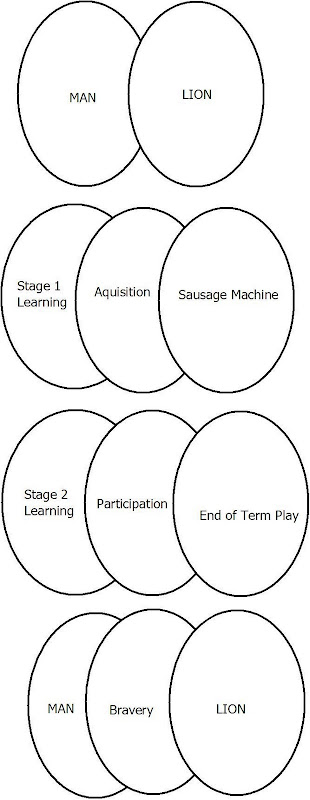There is no need for me to plug gaps - there aren't any.
There have been choices to make throough-out H800 wks 1-5. For the TMA01 we are to comment, 500 words each, on THREE activities (with a couple of exclusions which are required four the FOURTH part of the TMA).
Content to cover the ground and ill for the best part of three weeks I wasn't going to do my old thing of 'do everything' choose later ...
However, I thought this reading nmight be part of the 'compulsory' component on 'metaphor' in learning.
In fact, I find it a separate line of thinking entirely, far more pragmatic, and not even complemenetary to the idea of metaphor, though vital the thoughts we are developing on 'Acquisition' and 'participation' for the simple reason that this discussion wraps them up in one activity called 'Vicarious Learning'.
I found this diversion highly information, indeed so much so , that I feel without it I could not have come to my current level of appreciation of acquisition and participation, that instead of separate staged entities, they can be bound together in a single experience.
This idea of ‘vicarious learning’ has been popular with educational researchers as a topic since 1993 and originally formed part of Bandura’s (1977) work.
It is of course what happens all around – we learn by default, by observing others being taught, and either struggling or succeeding at a task or with a concept. Has human kind not done this always? You learn from your parents, siblings and peers, from uncles and aunts, elders and others in your immediate community and from any group or community your are sent to or put into in order to learn.
The suggestions it that ‘observed behaviours are reinforced’ … with a bias in favour of positive reinforcement of ‘good behaviour or outcomes’ rather than poo behaviour and none or negative outcomes. I wish I believed this to be the case and will need to see the research. There are always exceptions to the rule, people who pick up the bad habits and the way NOT to do a thing, or through their contrary nature deliberately go against the grain (though by doing so their formal learning would soon be ended).
Is observation ‘participation’ ? Surely it is?
Yes I learn as ‘one removed as it were’ from the interaction they are watching. Indeed, it is ‘acquisition’ too.
Reading this puts a wry smile on my face because of the way the language of e-learning has settled down, we come to accommodate phrases and ways of putting things that make sense to all in a less cumbersome fashion than this – it is the nature of language. ‘web-based generic shell designed to accept data from any discipline that has cases’.
The PATSy system looked at/looks at:
· Developmental reading disorder
· Neuropsychology
· Neurology/medical rehabilitation
· Speech and language pathologies
It is a:
· A multimedia database/resource.
· + virtual patients
· Clinical reasoning and diagnosis
‘Results showed that online interactions with PATSy were positively correlated with end-of-term learning outcome measures.’
It is helpful where students struggle to articulate their misunderstanding.
TDD (task-directed discussion)
Useful for reflection.
Especially to reveal what a student DOESN’T know, not what they DO know.
It provides:
· A multi-media database
· Discussion tools
· Reading resources
It operates:
· At a distance (does it say)
· On campus but working alone (clinical)
· As observers of learners and as learners themselves.
REFERENCE
Cox, R. (2006) Vicarious Learning and Case-based Teaching of Clinical Reasoning Skills (2004–2006) [online], http://www.esrcsocietytoday.ac.uk/ esrcinfocentre/ viewawardpage.aspx?awardnumber=RES-139-25-0127 [(last accessed 10 March 2011).

